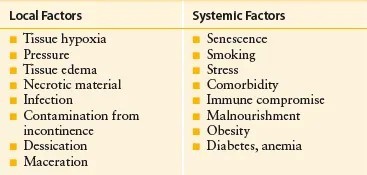The client is a 70-year-old female training for a triathlon. She was hit by a car while jogging and has an abrasion that is 25 cm by 12 cm on her right leg and a liver laceration. She underwent an exploratory laparotomy to repair the liver laceration and to search for other internal injuries.
The client has no chronic medical conditions and is in good health. She takes a calcium and magnesium supplement daily. She denies smoking or drinking alcohol.
What age-related factors may factor into this client's wound healing? Select all that apply.
Insulin resistance
Decreased epidermal turnover
Pigmentation changes
T-cell function decrease
Correct Answer : B,D
The age-related factors that may factor into this client's wound healing are: Decreased epidermal turnover: As people age, the turnover of skin cells decreases, resulting in slower wound healing. This can prolong the healing process and increase the risk of complications.
T-cell function decrease: The immune system's function, including T-cell function, tends to decline with age. T-cells play a crucial role in the immune response and wound healing. Decreased T-cell function can impair the body's ability to fight infection and promote efficient healing.
Insulin resistance and pigmentation changes are not directly age-related factors that impact wound healing. Insulin resistance is a condition related to impaired glucose metabolism and can affect wound healing in individuals with diabetes or other metabolic disorders, but it is not necessarily an age-related factor. Pigmentation changes are primarily cosmetic and do not directly affect the physiological processes involved in wound healing.

Nursing Test Bank
Naxlex Comprehensive Predictor Exams
Related Questions
Correct Answer is ["A","B","D"]
Explanation
The correct answer isa. Place a bedside commode next to bed.,b. Measure neurological vital signs every 4 hours.,d. Encourage family to participate in the client’s care.
Choice A rationale:
Placing a bedside commode next to the bed helps prevent falls and promotes independence in toileting, which is crucial for stroke patients who may have mobility issues.
Choice B rationale:
Measuring neurological vital signs every 4 hours is essential to monitor for any changes in the patient’s condition, which can help in early detection of complications.
Choice C rationale:
Suctioning the oral cavity every 4 hours is not typically necessary unless the patient has specific issues with swallowing or secretion management.Routine suctioning can also cause discomfort and potential injury.
Choice D rationale:
Encouraging family to participate in the client’s care provides emotional support and helps in the rehabilitation process.Family involvement can improve the patient’s motivation and adherence to the rehabilitation plan.
Choice E rationale:
Playing classical music in the room can be soothing and beneficial for some patients, but it is not a standard intervention for stroke rehabilitation.The effectiveness of music therapy can vary based on individual preferences.
Correct Answer is D
Explanation
A.While pain management is important, it is not the most critical intervention compared to monitoring for bleeding, which can be life-threatening.
B.Teaching the client how to use incentive spirometry is important for improving lung function and preventing complications like atelectasis. However, in the context of a pulmonary embolism (PE), the immediate priority is to monitor for signs of increased bleeding due to the anticoagulant or thrombolytic therapy often used to treat PE. This is crucial to prevent potentially life-threatening complications.
C.Confusion and restlessness could indicate hypoxia, which is important to monitor in a PE patient. However, the immediate risk of bleeding due to anticoagulation therapy takes precedence.
D.Patients with a pulmonary embolism are typically treated with thrombolytic or anticoagulant therapy to prevent further clot formation and to help dissolve the existing clot. Anticoagulants significantly increase the risk of bleeding, making it crucial to monitor for signs of increased bleeding as a priority in the plan of care.
Whether you are a student looking to ace your exams or a practicing nurse seeking to enhance your expertise , our nursing education contents will empower you with the confidence and competence to make a difference in the lives of patients and become a respected leader in the healthcare field.
Visit Naxlex, invest in your future and unlock endless possibilities with our unparalleled nursing education contents today
Report Wrong Answer on the Current Question
Do you disagree with the answer? If yes, what is your expected answer? Explain.
Kindly be descriptive with the issue you are facing.
